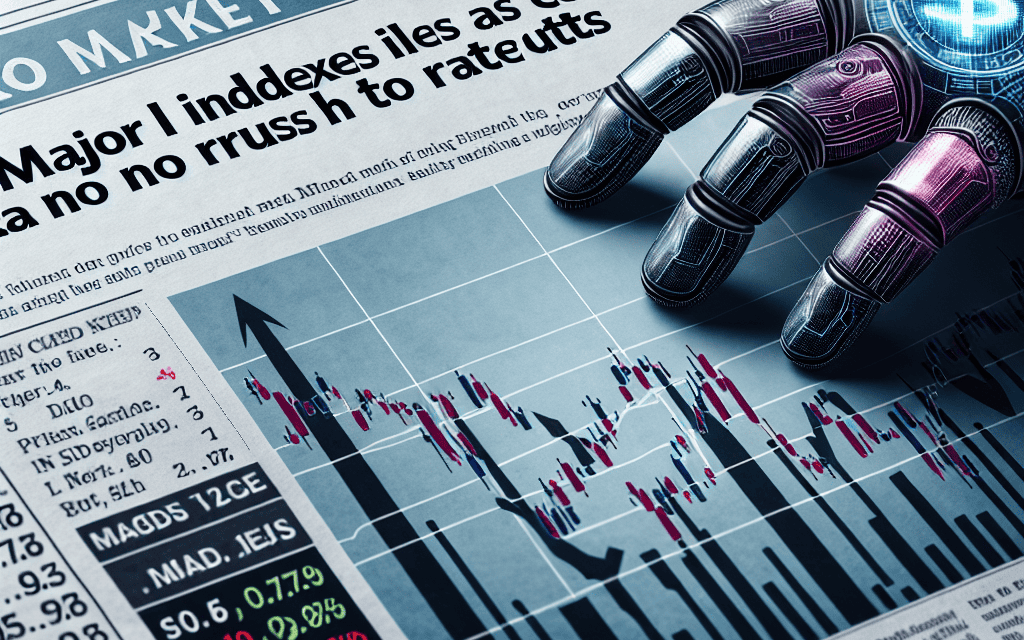“Markets Dip as Powell Pauses: No Rate Cuts on the Horizon”
Introduction
In a recent market update, the major U.S. stock indices—Dow Jones Industrial Average, S&P 500, and Nasdaq Composite—experienced declines following remarks from Federal Reserve Chair Jerome Powell. Powell’s comments suggested that the central bank is not in a hurry to implement rate cuts, a stance that has significant implications for investor sentiment and market dynamics. The anticipation of prolonged higher interest rates has led to increased caution among investors, contributing to the downward movement in stock prices. This development underscores the ongoing sensitivity of financial markets to monetary policy signals and the broader economic outlook.
Impact Of Powell’s Statement On The Stock Market
In recent developments within the financial markets, the stock market experienced a notable decline as Federal Reserve Chairman Jerome Powell signaled that there would be no immediate rush to cut interest rates. This announcement has had a significant impact on major indices, including the Dow Jones Industrial Average, the S&P 500, and the Nasdaq Composite, all of which registered declines. Investors, who had been anticipating potential rate cuts in response to economic conditions, were met with a more cautious stance from the Federal Reserve, leading to a recalibration of market expectations.
The Dow Jones Industrial Average, a key indicator of market performance, saw a decrease as investors digested Powell’s remarks. The S&P 500, which represents a broader swath of the market, also experienced a downturn. Similarly, the tech-heavy Nasdaq Composite was not immune to the effects of Powell’s statement, as it too recorded a decline. This collective movement in the indices underscores the sensitivity of the stock market to monetary policy signals and the broader economic outlook.
Powell’s statement comes at a time when the market is grappling with various economic indicators that suggest a mixed picture of the U.S. economy. While some sectors have shown resilience, others have exhibited signs of slowing growth. In this context, the Federal Reserve’s decision to maintain its current interest rate policy reflects a cautious approach aimed at balancing the need to support economic growth while keeping inflation in check. By signaling no immediate rate cuts, Powell has effectively communicated the Fed’s commitment to a data-driven approach, which prioritizes long-term economic stability over short-term market fluctuations.
The impact of Powell’s statement extends beyond the immediate reaction in the stock market. It also influences investor sentiment and decision-making processes. With interest rates remaining steady, investors may reassess their portfolios, considering the implications for sectors that are sensitive to borrowing costs. For instance, industries such as real estate and consumer goods, which often rely on lower interest rates to drive demand, may face headwinds. Conversely, financial institutions might benefit from a stable rate environment, as it allows for more predictable lending conditions.
Moreover, Powell’s remarks have implications for global markets as well. The U.S. Federal Reserve’s policies often set the tone for central banks worldwide, influencing global capital flows and currency valuations. As such, international investors closely monitor these developments, adjusting their strategies in response to shifts in U.S. monetary policy. The interconnectedness of global markets means that Powell’s statement could have ripple effects, impacting everything from emerging market equities to foreign exchange rates.
In conclusion, the decline in the Dow, S&P 500, and Nasdaq following Powell’s indication of no immediate rate cuts highlights the intricate relationship between monetary policy and market dynamics. As investors navigate this landscape, they must weigh the implications of a steady interest rate environment against the backdrop of evolving economic conditions. While the immediate market reaction may be one of caution, the long-term effects of Powell’s statement will depend on how economic indicators unfold in the coming months. Ultimately, the Federal Reserve’s commitment to a measured approach underscores the complexity of managing economic growth and stability in an ever-changing global landscape.
Analysis Of Dow, S&P 500, And Nasdaq Performance
In recent trading sessions, the stock market has experienced a notable decline, with the Dow Jones Industrial Average, the S&P 500, and the Nasdaq Composite all registering losses. This downturn can be attributed to Federal Reserve Chair Jerome Powell’s recent remarks, which signaled that there is no immediate rush to cut interest rates. Investors, who had been hopeful for a more dovish stance from the Federal Reserve, reacted to Powell’s comments with caution, leading to a sell-off across major indices.
The Dow Jones Industrial Average, a key barometer of the U.S. stock market, has seen a decrease in its value as investors reassess their expectations for monetary policy. The index, which comprises 30 large publicly traded companies, is often viewed as a reflection of the broader economic landscape. As Powell emphasized the need for a cautious approach to rate cuts, market participants recalibrated their strategies, resulting in downward pressure on the Dow. This shift underscores the sensitivity of the market to central bank communications and the broader implications of monetary policy on economic growth.
Similarly, the S&P 500, which represents a broader spectrum of the market with its inclusion of 500 leading companies, has also experienced a decline. The index’s performance is often seen as a proxy for the overall health of the U.S. economy. Powell’s indication that rate cuts are not imminent has led to a reassessment of growth prospects, particularly in sectors that are sensitive to interest rate changes. As a result, companies within the S&P 500 that are heavily reliant on borrowing or are in growth phases have faced increased scrutiny from investors, contributing to the index’s downward trajectory.
The Nasdaq Composite, known for its heavy concentration of technology stocks, has not been immune to the recent market downturn. The tech sector, which has been a significant driver of market gains in recent years, is particularly sensitive to interest rate expectations. Higher rates can increase borrowing costs and reduce the present value of future earnings, which is a critical consideration for tech companies with high growth potential. Consequently, Powell’s comments have prompted a reevaluation of valuations within the tech sector, leading to a pullback in the Nasdaq.
Transitioning from the immediate market reaction, it is essential to consider the broader economic context in which these developments are occurring. The Federal Reserve’s cautious stance on rate cuts reflects ongoing concerns about inflationary pressures and the need to maintain economic stability. While some investors may have anticipated a more aggressive approach to rate reductions, the central bank’s focus on data-driven decision-making highlights the complexity of balancing growth and inflation.
Moreover, the global economic environment continues to play a significant role in shaping market dynamics. Geopolitical tensions, trade uncertainties, and varying economic conditions across regions contribute to the volatility observed in financial markets. As investors navigate these challenges, the importance of diversification and risk management becomes increasingly apparent.
In conclusion, the recent decline in the Dow, S&P 500, and Nasdaq underscores the intricate relationship between monetary policy and market performance. Powell’s indication that rate cuts are not forthcoming has prompted a reassessment of growth prospects and valuations across sectors. As the market continues to digest these developments, investors will need to remain vigilant and adaptable, considering both domestic and global factors that influence the economic landscape.
Investor Reactions To Federal Reserve’s Stance
In recent developments, the stock market has experienced a notable decline, with the Dow Jones Industrial Average, the S&P 500, and the Nasdaq Composite all registering losses. This downturn comes in the wake of Federal Reserve Chair Jerome Powell’s remarks, which signaled that the central bank is in no hurry to implement rate cuts. Investors, who had been eagerly anticipating a more dovish stance from the Federal Reserve, reacted with caution and concern, leading to a sell-off across major indices.
Powell’s comments, delivered during a closely watched press conference, emphasized the Federal Reserve’s commitment to maintaining its current monetary policy until there is clear evidence of sustained economic recovery. While acknowledging the progress made in combating inflation, Powell underscored the importance of remaining vigilant against potential economic headwinds. This cautious approach, while aimed at ensuring long-term stability, has left investors grappling with uncertainty regarding the future trajectory of interest rates.
The immediate reaction in the stock market was palpable, as investors recalibrated their expectations in light of Powell’s statements. The Dow Jones Industrial Average, a key barometer of market sentiment, fell sharply, reflecting the broader apprehension among market participants. Similarly, the S&P 500 and the Nasdaq Composite, which are often seen as indicators of broader economic health, also experienced declines. This collective downturn underscores the sensitivity of the markets to signals from the Federal Reserve, particularly in an environment where economic recovery remains uneven.
Transitioning to the broader implications of Powell’s remarks, it is evident that the Federal Reserve’s cautious stance is rooted in a desire to avoid premature policy shifts that could destabilize the economy. By signaling a reluctance to cut rates hastily, the central bank aims to provide a buffer against potential inflationary pressures that could arise from a rapidly recovering economy. This approach, while prudent, has introduced a degree of uncertainty that investors must now navigate.
Moreover, the Federal Reserve’s stance has prompted a reassessment of risk among investors, leading to a shift in asset allocation strategies. With interest rates expected to remain elevated for the foreseeable future, investors are likely to seek refuge in sectors that are less sensitive to rate fluctuations. This shift could result in increased volatility in certain segments of the market, as investors adjust their portfolios to align with the evolving economic landscape.
In addition to influencing market dynamics, Powell’s comments have also sparked a broader conversation about the role of central banks in managing economic recovery. As the global economy continues to grapple with the aftermath of the pandemic, central banks are faced with the challenge of balancing growth and stability. The Federal Reserve’s cautious approach serves as a reminder of the delicate equilibrium that policymakers must maintain in order to foster sustainable economic growth.
In conclusion, the recent decline in the stock market, triggered by Powell’s remarks, highlights the intricate relationship between monetary policy and investor sentiment. As the Federal Reserve signals its intention to maintain a steady course, investors are left to navigate an environment characterized by uncertainty and cautious optimism. While the path forward remains uncertain, the central bank’s commitment to stability provides a measure of reassurance in an otherwise volatile landscape. As investors continue to digest the implications of Powell’s comments, the coming weeks will be crucial in determining the market’s trajectory and the broader economic outlook.
Long-term Implications Of Delayed Rate Cuts

In recent developments, the stock market has experienced a notable decline, with the Dow Jones Industrial Average, S&P 500, and Nasdaq Composite all registering losses. This downturn can be attributed to Federal Reserve Chair Jerome Powell’s recent remarks, which signaled that there would be no immediate rush to implement rate cuts. As investors digest this information, it is crucial to consider the long-term implications of delayed rate cuts on the broader economic landscape.
To begin with, the Federal Reserve’s decision to maintain interest rates at their current levels reflects its ongoing commitment to curbing inflation. By keeping rates elevated, the Fed aims to temper economic activity and prevent the economy from overheating. However, this approach also has significant ramifications for the stock market. Higher interest rates typically lead to increased borrowing costs for businesses, which can, in turn, dampen corporate profits and reduce investor enthusiasm. Consequently, the recent decline in major stock indices can be seen as a direct response to the anticipated prolonged period of elevated rates.
Moreover, the delay in rate cuts may have broader implications for economic growth. While higher interest rates are effective in controlling inflation, they can also stifle economic expansion by making credit more expensive for consumers and businesses alike. This can lead to reduced consumer spending and business investment, both of which are critical drivers of economic growth. As a result, the economy may experience a slowdown, which could further weigh on stock market performance in the long run.
In addition to these economic considerations, the delayed rate cuts also have implications for investor sentiment. The stock market is often driven by expectations, and the prospect of prolonged high interest rates can create uncertainty among investors. This uncertainty can lead to increased market volatility as investors reassess their portfolios and adjust their strategies in response to the changing economic environment. Consequently, the stock market may experience heightened fluctuations as market participants navigate this period of uncertainty.
Furthermore, the impact of delayed rate cuts extends beyond the domestic market, influencing global financial markets as well. The United States plays a pivotal role in the global economy, and changes in its monetary policy can have ripple effects worldwide. As the Fed maintains its current stance, other central banks may also be influenced to adjust their policies accordingly. This interconnectedness means that the implications of delayed rate cuts are not confined to the U.S. alone but can affect global economic stability and growth prospects.
In light of these considerations, it is essential for investors to adopt a long-term perspective when evaluating the implications of delayed rate cuts. While the immediate reaction in the stock market may be negative, it is important to recognize that the Fed’s actions are aimed at ensuring sustainable economic growth and stability. By maintaining a cautious approach, the Fed seeks to strike a balance between controlling inflation and supporting economic expansion.
In conclusion, the recent decline in the Dow, S&P 500, and Nasdaq underscores the complex interplay between monetary policy and stock market performance. As the Federal Reserve signals no rush for rate cuts, investors must carefully consider the long-term implications of this decision. While challenges may arise in the short term, a measured approach to monetary policy can ultimately contribute to a more stable and resilient economic environment.
Sector-specific Effects Of Market Decline
The recent decline in the stock market, marked by downturns in the Dow Jones Industrial Average, the S&P 500, and the Nasdaq Composite, has sent ripples across various sectors, each reacting uniquely to the signals from Federal Reserve Chair Jerome Powell regarding the future of interest rates. As Powell indicated no immediate rush to cut rates, investors have been prompted to reassess their strategies, leading to sector-specific impacts that are worth examining.
To begin with, the technology sector, which has been a significant driver of market gains in recent years, has experienced notable volatility. The Nasdaq, heavily weighted with tech stocks, has been particularly sensitive to interest rate expectations. Higher rates can increase borrowing costs and reduce the present value of future earnings, which is a critical consideration for tech companies that often rely on projected growth. Consequently, tech giants and smaller firms alike have seen their stock prices fluctuate as investors recalibrate their expectations in light of Powell’s comments.
Meanwhile, the financial sector has also been affected, albeit in a different manner. Banks and financial institutions generally benefit from higher interest rates, as they can charge more for loans relative to what they pay on deposits. However, the lack of immediate rate cuts suggests a prolonged period of economic uncertainty, which can dampen loan demand and increase the risk of defaults. This duality has led to mixed performances within the sector, with some institutions faring better than others based on their exposure to various economic factors.
In contrast, the consumer goods sector has shown resilience amid the market decline. Companies in this sector often provide essential products that remain in demand regardless of economic conditions. However, they are not entirely immune to broader market trends. The potential for sustained higher interest rates can lead to increased costs for these companies, particularly those with significant debt. As a result, while consumer goods stocks have not been as volatile as tech stocks, they still face challenges that could impact their long-term performance.
The energy sector, on the other hand, has been influenced by both market dynamics and external factors such as geopolitical tensions and fluctuating oil prices. While higher interest rates can increase operational costs for energy companies, the sector’s performance is also closely tied to global supply and demand dynamics. Recent market declines have coincided with shifts in oil prices, creating a complex environment for energy stocks. Investors in this sector must navigate not only the implications of Powell’s statements but also the broader geopolitical landscape.
Furthermore, the real estate sector is particularly sensitive to interest rate changes, as they directly affect mortgage rates and property valuations. The prospect of sustained higher rates can lead to decreased affordability for homebuyers and reduced demand for commercial properties. This has resulted in a cautious approach from investors, who are closely monitoring the Federal Reserve’s actions and their potential impact on real estate markets.
In summary, the recent stock market decline, driven by Powell’s indication of no immediate rate cuts, has had varied effects across different sectors. While technology and financial stocks have experienced volatility, consumer goods have shown relative stability, and energy and real estate face unique challenges. As investors continue to digest these developments, the interplay between interest rates and sector-specific factors will remain a critical area of focus in the coming months.
Historical Context Of Rate Cut Announcements
The history of rate cut announcements by the Federal Reserve is a fascinating journey through the economic ebbs and flows that have shaped the financial landscape of the United States. Understanding this history provides valuable context for the recent declines in the Dow, S&P 500, and Nasdaq, following Federal Reserve Chair Jerome Powell’s indication that there is no immediate rush to cut interest rates. Historically, the Federal Reserve has used rate cuts as a tool to stimulate economic growth during periods of economic downturn or uncertainty. By lowering interest rates, borrowing becomes cheaper, encouraging businesses to invest and consumers to spend, thereby boosting economic activity. This strategy has been employed during various economic crises, such as the financial crisis of 2008, when the Fed slashed rates to near zero to stabilize the economy.
Transitioning to more recent times, the COVID-19 pandemic presented another scenario where rate cuts were deemed necessary. In March 2020, as the pandemic began to wreak havoc on global economies, the Federal Reserve once again reduced interest rates to near zero. This move was part of a broader strategy to support the economy during an unprecedented health crisis, aiming to mitigate the economic fallout by encouraging spending and investment. However, as the economy began to recover, the focus shifted towards managing inflation, which had started to rise due to supply chain disruptions and increased demand.
In this context, Jerome Powell’s recent remarks about the lack of urgency for rate cuts can be seen as a reflection of the current economic conditions. Inflation, while moderating, remains a concern, and the Federal Reserve is cautious about cutting rates too soon, which could potentially reignite inflationary pressures. This cautious stance is consistent with the Fed’s dual mandate of promoting maximum employment and stabilizing prices. By signaling a steady approach, Powell aims to balance these objectives without derailing the economic recovery.
The stock market’s reaction to Powell’s comments underscores the sensitivity of financial markets to monetary policy signals. Historically, announcements or even hints of rate cuts have often led to market rallies, as investors anticipate lower borrowing costs and improved corporate profitability. Conversely, indications of a delay in rate cuts can lead to market declines, as seen in the recent performance of the Dow, S&P 500, and Nasdaq. Investors, always forward-looking, adjust their expectations based on the perceived trajectory of monetary policy, which in turn influences market dynamics.
Moreover, the current market environment is characterized by a complex interplay of factors, including geopolitical tensions, technological advancements, and evolving consumer behaviors, all of which add layers of complexity to the Federal Reserve’s decision-making process. As such, Powell’s cautious approach is not only a response to domestic economic indicators but also a consideration of the broader global economic landscape.
In conclusion, the historical context of rate cut announcements provides a lens through which to view the current market situation. While the Federal Reserve has historically used rate cuts as a tool to stimulate growth, the present economic environment necessitates a more measured approach. Jerome Powell’s indication of no immediate rush for rate cuts reflects a careful balancing act aimed at sustaining economic recovery while keeping inflation in check. As investors navigate this landscape, understanding the historical precedents and current economic conditions will be crucial in anticipating future market movements.
Strategies For Investors During Market Volatility
In the ever-evolving landscape of financial markets, investors are constantly seeking strategies to navigate periods of volatility. Recent developments have underscored the importance of such strategies, as the Dow, S&P 500, and Nasdaq experienced declines following Federal Reserve Chair Jerome Powell’s indication that there is no immediate rush to cut interest rates. This announcement has sent ripples through the market, prompting investors to reassess their portfolios and consider how best to manage their investments during uncertain times.
To begin with, understanding the underlying causes of market volatility is crucial for investors. Powell’s remarks suggest a cautious approach to monetary policy, reflecting concerns about inflation and economic stability. This has led to increased uncertainty, as investors grapple with the implications of sustained higher interest rates. In such an environment, it is essential for investors to remain informed and adaptable, recognizing that market conditions can shift rapidly based on economic data and policy decisions.
One effective strategy during periods of volatility is diversification. By spreading investments across a range of asset classes, sectors, and geographies, investors can mitigate risk and reduce the impact of market fluctuations on their portfolios. Diversification acts as a buffer, ensuring that a downturn in one area does not disproportionately affect overall performance. Moreover, it allows investors to capitalize on opportunities in different segments of the market, potentially offsetting losses with gains elsewhere.
In addition to diversification, maintaining a long-term perspective is vital. Market volatility can often lead to emotional decision-making, with investors tempted to react impulsively to short-term movements. However, history has shown that markets tend to recover over time, rewarding those who remain patient and committed to their investment goals. By focusing on long-term objectives and avoiding knee-jerk reactions, investors can better weather the storm and position themselves for future growth.
Furthermore, during volatile periods, it is prudent for investors to reassess their risk tolerance and investment objectives. This involves evaluating whether their current portfolio aligns with their financial goals and risk appetite. For some, this may mean adjusting asset allocations or exploring alternative investments that offer greater stability or potential for growth. By aligning their portfolios with their risk tolerance, investors can navigate market turbulence with greater confidence and clarity.
Another strategy to consider is dollar-cost averaging, which involves regularly investing a fixed amount of money regardless of market conditions. This approach can help investors avoid the pitfalls of trying to time the market, as it reduces the impact of short-term volatility on investment decisions. Over time, dollar-cost averaging can lead to a lower average cost per share, potentially enhancing returns when markets stabilize.
Finally, staying informed and seeking professional advice can be invaluable during periods of market volatility. Financial advisors can provide insights and guidance tailored to individual circumstances, helping investors make informed decisions that align with their goals. Additionally, keeping abreast of economic indicators, corporate earnings reports, and geopolitical developments can provide valuable context for understanding market movements and potential opportunities.
In conclusion, while market volatility can be unsettling, it also presents opportunities for investors who are prepared and strategic. By embracing diversification, maintaining a long-term perspective, reassessing risk tolerance, considering dollar-cost averaging, and seeking professional advice, investors can navigate uncertain times with greater resilience and poise. As the market continues to respond to Powell’s signals and other economic factors, these strategies can serve as a foundation for informed and effective investment decision-making.
Q&A
1. **What happened to the stock market recently?**
The Dow, S&P 500, and Nasdaq all experienced declines.
2. **Who is Jerome Powell?**
Jerome Powell is the Chair of the Federal Reserve.
3. **What did Jerome Powell signal regarding interest rates?**
Powell signaled that there is no rush to cut interest rates.
4. **How did Powell’s comments affect the stock market?**
His comments contributed to the decline in the stock market indices.
5. **Why are interest rates important to the stock market?**
Interest rates influence borrowing costs and economic activity, impacting corporate profits and stock valuations.
6. **What is the general investor sentiment following Powell’s remarks?**
Investors are cautious or concerned due to the indication of prolonged higher interest rates.
7. **What sectors were most affected by the market decline?**
Typically, interest rate-sensitive sectors like technology and real estate may be more affected, but specific sector performance can vary.
Conclusion
The stock market experienced a decline as the Dow, S&P 500, and Nasdaq all fell following Federal Reserve Chair Jerome Powell’s indication that there is no immediate plan to cut interest rates. This suggests that investors are reacting to the prospect of prolonged higher interest rates, which can impact borrowing costs and economic growth. The market’s response reflects concerns about the potential for tighter financial conditions and their effect on corporate earnings and consumer spending. Overall, Powell’s comments have introduced caution into the market, leading to a pullback in major indices.





